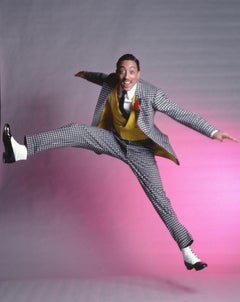Jack Hines
1980s Pop Art Black and White Photography
Silver Gelatin
1980s Pop Art Color Photography
Archival Pigment
People Also Browsed
1970s Contemporary Black and White Photography
Photographic Film, Photographic Paper, Silver Gelatin
21st Century and Contemporary Chinese Wallpaper
Silk
1990s Pop Art Black and White Photography
Silver Gelatin
Antique 19th Century French Medieval Wall-mounted Sculptures
Walnut
Vintage 1950s Italian Mid-Century Modern Scientific Instruments
Glass, Plastic, Wood
1970s Pop Art Black and White Photography
Silver Gelatin
Antique 1790s European Baroque Wall-mounted Sculptures
Walnut, Pine
Antique Early 18th Century German Baroque Commodes and Chests of Drawers
Brass
21st Century and Contemporary Mid-Century Modern Scientific Instruments
Steel
1950s Contemporary Black and White Photography
Archival Ink, Photographic Film, Archival Paper, Digital, Digital Pigmen...
1980s Pop Art Color Photography
Archival Pigment
Early 20th Century Italian Neoclassical Figurative Sculptures
Granite, Marble
Antique 1680s Spanish Baroque Wall-mounted Sculptures
Walnut, Giltwood, Paint
1970s Pop Art Black and White Photography
Silver Gelatin
Antique 1780s English Georgian Arms, Armor and Weapons
Walnut
Antique 1720s French Baroque Commodes and Chests of Drawers
Brass
Jack Hines For Sale on 1stDibs
How Much are Jack Hines?
Jack Mitchell for sale on 1stDibs
Over his four-decade career, photographer Jack Mitchell chronicled the changing cultural landscape of mid- to late-20th-century America by capturing the greatest influencers and innovators in the performing and visual arts.
Mitchell, a master of lighting patterns in photography who had his first portrait published at the age of 15, organized more than 5,400 photographic sessions in his lifetime involving a list of sitters that is as astounding as it is long. A veritable roll call of heroes and idols, his studio guests include painters, dancers, actors, comedians, singers, composers, directors, writers, impresarios and anyone else who helped shape the zeitgeist.
During World War II, when he was only 16 years old, Mitchell photographed Veronica Lake for a Daytona newspaper. It was his first celebrity gig, but that didn’t stop the audacious wunderkind from asking the actress to sweep back her signature “peekaboo” locks so he could get her full face in the frame. Lake, who was in Florida to help the war effort and at the peak of her career, politely obliged, and the two later became lifelong friends.
Mitchell, who was openly gay (his long-term partner and manager, Robert Plavik, died in 2009), also struck up a close relationship with Gloria Swanson. From 1960 to 1970, he served as her personal paparazzo, snapping a variety of “candid” shots of the aging but eternally glamorous actress as if she were a pre-mobile/pre-social-media reality star.
The diverse publications in which Mitchell’s work has appeared — in addition to the New York Times, there’s Rolling Stone, Dance Magazine, People, Vogue, Vanity Fair, Time, Harper’s Bazaar and Newsweek — testify to the power of his arresting visual language and its ability to transcend themes and disciplines.
Mitchell also famously shot a series of intimate portraits of John Lennon and Yoko Ono in November 1980, just one month before the Beatles singer was assassinated. A picture from this session became the cover of People’s memorial issue, one of the magazine’s best-selling editions to date.
The showbiz gloss should not distract from Mitchell’s meticulous approach to photography. He insisted on producing his own prints in order to achieve what he deemed museum-quality patina and definition.
“Jack shot many rolls of black-and-white film, and always some color transparencies, of every famous person he photographed,” says Craig Highberger, a friend of the late photographer and the executive director of the Jack Mitchell Archives.
In the world of dance, the field for which Mitchell is best known, his striking and incisive shots of legendary performers and choreographers reflect the visceral energy that these luminaries introduced to the discipline in the 1960s and ’70s, widely considered the Golden Age of American dance theater.
“Jack’s photographs of dancers during his lifetime are a historic chronicle of an amazing period in dance history. He was Alvin Ailey’s dance company photographer from 1961 to 1994,” says Highberger, noting that Mitchell’s collection of 10,000 black-and-white Ailey prints now belongs to the Smithsonian’s National Museum of African American History and Culture.
Mitchell’s dance images are at once ethereal and powerfully dynamic. Not only do they evoke movement through elegant poses and disciplined muscular tension, but they also convey an intimate energy radiating directly from his subjects, as if he had magically unlocked a reflective mood or a character trait, without contrivance.
The collection of authentic Jack Mitchell photography on 1stDibs includes his black and white photography, color photography, nude photography and more.
A Close Look at Pop Art Art
Perhaps one of the most influential contemporary art movements, Pop art emerged in the 1950s. In stark contrast to traditional artistic practice, its practitioners drew on imagery from popular culture — comic books, advertising, product packaging and other commercial media — to create original Pop art paintings, prints and sculptures that celebrated ordinary life in the most literal way.
ORIGINS OF POP ART
- Started in Britain in the 1950s, flourished in 1960s-era America
- “This is Tomorrow,” at London's Whitechapel Gallery in 1956, was reportedly the first Pop art exhibition
- A reaction to postwar mass consumerism
- Transitioning away from Abstract Expressionism
- Informed by neo-Dada and artists such as Jasper Johns and Robert Rauschenberg; influenced postmodernism and Photorealism
CHARACTERISTICS OF POP ART
- Bold imagery
- Bright, vivid colors
- Straightforward concepts
- Engagement with popular culture
- Incorporation of everyday objects from advertisements, cartoons, comic books and other popular mass media
POP ARTISTS TO KNOW
- Richard Hamilton
- Andy Warhol
- Marta Minujín
- Claes Oldenburg
- Eduardo Paolozzi
- Rosalyn Drexler
- James Rosenquist
- Peter Blake
- Roy Lichtenstein
ORIGINAL POP ART ON 1STDIBS
The Pop art movement started in the United Kingdom as a reaction, both positive and critical, to the period’s consumerism. Its goal was to put popular culture on the same level as so-called high culture.
Richard Hamilton’s 1956 collage Just what is it that makes today’s homes so different, so appealing? is widely believed to have kickstarted this unconventional new style.
Pop art works are distinguished by their bold imagery, bright colors and seemingly commonplace subject matter. Practitioners sought to challenge the status quo, breaking with the perceived elitism of the previously dominant Abstract Expressionism and making statements about current events. Other key characteristics of Pop art include appropriation of imagery and techniques from popular and commercial culture; use of different media and formats; repetition in imagery and iconography; incorporation of mundane objects from advertisements, cartoons and other popular media; hard edges; and ironic and witty treatment of subject matter.
Although British artists launched the movement, they were soon overshadowed by their American counterparts. Pop art is perhaps most closely identified with American Pop artist Andy Warhol, whose clever appropriation of motifs and images helped to transform the artistic style into a lifestyle. Most of the best-known American artists associated with Pop art started in commercial art (Warhol made whimsical drawings as a hobby during his early years as a commercial illustrator), a background that helped them in merging high and popular culture.
Roy Lichtenstein was another prominent Pop artist that was active in the United States. Much like Warhol, Lichtenstein drew his subjects from print media, particularly comic strips, producing paintings and sculptures characterized by primary colors, bold outlines and halftone dots, elements appropriated from commercial printing. Recontextualizing a lowbrow image by importing it into a fine-art context was a trademark of his style. Neo-Pop artists like Jeff Koons and Takashi Murakami further blurred the line between art and popular culture.
Pop art rose to prominence largely through the work of a handful of men creating works that were unemotional and distanced — in other words, stereotypically masculine. However, there were many important female Pop artists, such as Rosalyn Drexler, whose significant contributions to the movement are recognized today. Best known for her work as a playwright and novelist, Drexler also created paintings and collages embodying Pop art themes and stylistic features.
Read more about the history of Pop art and the style’s famous artists, and browse the collection of original Pop art paintings, prints, photography and other works for sale on 1stDibs.
Finding the Right Portrait-photography for You
Portrait photography can be a powerful part of your wall decor. Find a provocative and compelling portrait that speaks to you and you might find that the photograph will speak to your guests too.
Prior to the development of photography, which eventually replaced portrait paintings as a quicker and more efficient way of capturing a person’s essence, the subject of a portrait had to sit for hours until the painter had finished. In 1839, chemist and Philadelphia-based photographer Robert Cornelius didn’t have to wait very long for his portrait. In a matter of minutes, he captured what many believe to be the first portrait photograph. This shot was also the first self-portrait (or what we now call a “selfie”), and fine photography quickly became an art form.
Landscape photography, nude photography and portrait photography are very popular in today's modern interiors. A portrait can reveal a lot about the person in it. It can also add a narrative touch to your decor. You’ll often find that photographs of loved ones work well as decorative touches. A portrait of a family member or dear friend can help turn a house into a home, warming any space by evoking fond memories.
While family portraits can stir emotion, portraits of celebrities and important historical figures can also add a rich dynamic to your space. Portraits of famous musicians or intriguing actors hung in your dining room or home bar shot by Gered Mankowitz or Annie Leibovitz might inspire deep conversation over meals or drinks. Douglas Kirkland is also famous for his celebrity portraits. His photojournalism made him much sought after by Hollywood studios to document the filming of movies. In Kirkland’s powerful depiction of Hollywood stars, he excellently captures the glamour of their lives.
Other artists like Elliott Erwitt stand out by turning portraiture into a playful art form. Before graduating from high school in Hollywood, Erwitt had already begun to teach himself to take pictures, inspired by the work of Henri Cartier-Bresson. In image after image, Erwitt captured what photographers call “the moment” with rapier wit and penetrating humanity.
Portrait photography can be incredibly expressive, setting the tone and mood for a room. And there are different ways of incorporating portrait photography into your interior decor. If you’re thinking about adding color photography to a bedroom or living room, the colors of the portraits can become part of the room’s palette, while portraits shot in black and white won’t disrupt an existing color scheme.
On 1stDibs, find a vast selection of portrait photography from different eras, including 1950s portraits, 1960s portrait photography and more.

